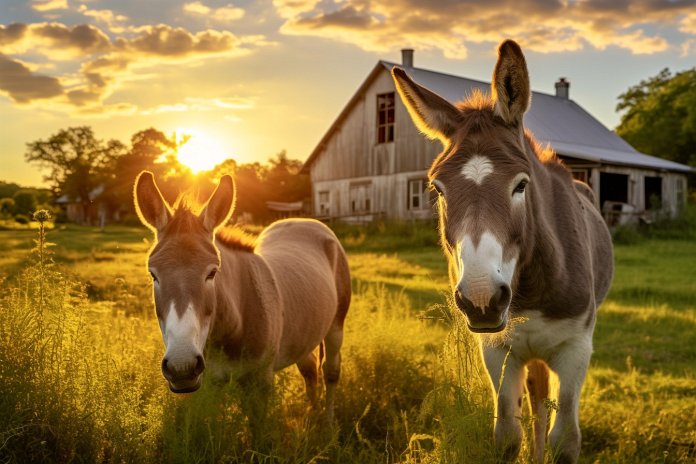
When thinking about dogs, we often consider them to be man’s best friend. But can dogs be friends with other animals that are commonly found on farms or kept as pets, such as cats, sheep, horses, and donkeys? Luckily, dogs are known for being social and trainable, which means they tend to do well with different species. Working and herding dogs often have instincts around other animals, making them naturally skilled at interacting with them. But how do donkeys handle being around dogs? Can they be friends?
Signs That Dogs Could Live with Donkeys
Dogs are generally great at making friends. They are social animals and don’t seem to mind the species of the animal they interact with. However, it is important to introduce two unfamiliar animals slowly, regardless of their size. Dogs are naturally curious creatures, so they are likely to show interest in donkeys. You may notice your dog wagging its tail, barking with excitement, becoming alert and perking its ears up, or whimpering when it can’t investigate the unfamiliar creature.
Body Language
Dogs use body language to communicate, and when they are excited to meet a new creature, they may display signs such as being alert, barking, wagging their tail, raising their ears, whimpering, or perking their ears up.
Other Signs
Other signs that your dog could live with a donkey include displaying friendly behavior, staying close to the donkey, having a calm temperament, and having a history of getting along well with other animals.
History of Dogs Living with Donkeys
In the past, and even on some farms today, dogs and donkeys were kept in close quarters. Both animals were considered workers on the farm and likely spent a lot of time together. However, it is essential to consider the personalities of the two animals before introducing them. Donkeys can be stubborn and difficult to get along with, while dogs are typically social, eager to please, and curious. A slow introduction, where the animals can get used to each other without direct access, is recommended. Once they are familiar with each other, you can gradually allow them to get closer, ensuring their comfort and preventing any incidents. If either animal has a history of negative interactions with other animals, it is best to focus on their individual training before attempting introductions.
Science Behind Whether Dogs and Donkeys Can Co-Exist
Dogs are highly social and adaptable creatures, making them great companions for various other animals. Their herding instincts also make them comfortable around large, hooved animals. Dogs are often used to help herd cattle and sheep without causing harm. However, donkeys do not possess the same social skills as dogs. While dogs are unlikely to hurt a donkey, the donkey may try to kick or stomp on the dog. If you want to keep dogs and donkeys together, it is advisable to do so with large dogs that are trained to be around large animals like donkeys.
Training Your Dog to Live with Donkeys
Training dogs to interact positively with other animal species is usually easier than training donkeys. To ensure coexistence, it is best to train your dog on how to behave around donkeys so that the donkey doesn’t harm the dog. A slow introduction is recommended, where both animals are on leads with responsible individuals. They should start off at a distance where they can see each other but not get close enough to start any interactions. Gradually move them closer to each other as long as they remain calm. If they can’t settle down, take steps backward or postpone the introduction. Keep the animals leashed around each other for a while to maintain control. Once they seem comfortable, supervised free interaction can be considered, but be cautious as donkeys have a powerful kick and dogs can nip or make the donkey uncomfortable by getting too close.
It is important not to leave the two animals alone together right away. Animals need time to learn how to interact with each other, and rushing the process can lead to serious injuries. Since dogs usually live in houses and donkeys in barns, it is relatively easy to keep them apart until they are ready to safely interact.
“Slow and steady introductions pave the way for unlikely friendships.”

Tips & Things to Know
1️⃣ Introduce animals slowly: It is important to introduce dogs and donkeys slowly to ensure their safety. Letting unfamiliar animals loose near each other can be dangerous, so take the time to introduce them gradually.
2️⃣ Watch for body language: Dogs use body language to communicate, so pay attention to their signs of excitement or curiosity when they encounter a donkey. This can include barking, wagging their tail, raising their ears, or whimpering.
3️⃣ Train your dog: While dogs are generally social and adaptable, donkeys may not have the same social skills. It is important to train your dog to behave properly around donkeys to prevent any harm or aggression. Start with a slow introduction and keep them leashed until they are comfortable being around each other.
Frequently Asked Questions, Answered ✅
1. Can dogs be friends with other animals, such as cats, sheep, horses, and donkeys?
– Yes, dogs are social and trainable, making them adaptable to different species.
2. How can you tell if a dog is interested in interacting with a donkey?
– Signs include wagging tail, barking, alertness, raised ears, and whimpering.
3. What factors should be considered before introducing a dog and a donkey?
– The personalities of both animals, as donkeys can be stubborn and dogs are generally social. A slow introduction is recommended.
4. Can dogs and donkeys coexist peacefully?
– While dogs are unlikely to harm donkeys, donkeys may try to kick or stomp on dogs. Large, well-trained dogs are more suitable for close quarters with donkeys.
5. How can you train a dog to live with a donkey?
– A slow introduction, keeping both animals on leads and gradually bringing them closer, can help them become comfortable with each other. Leashing them around each other for a while is recommended, as donkeys can kick and dogs can nip. Rushing the process can lead to injuries.